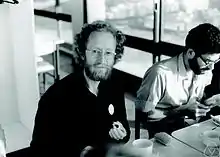Oscar Lanford | |
|---|---|
 | |
| Born | January 9, 1940 New York City, US |
| Died | November 16, 2013 (aged 73) |
| Nationality | American |
| Alma mater | Princeton University Wesleyan University |
| Scientific career | |
| Fields | Mathematical physics |
| Institutions | University of California, Berkeley Institut des Hautes Études Scientifiques ETH Zürich |
| Doctoral advisor | Arthur Wightman |
Oscar Erasmus Lanford III (January 6, 1940 – November 16, 2013) was an American mathematician working on mathematical physics and dynamical systems theory.[1]
Professional career
Born in New York, Lanford was awarded his undergraduate degree from Wesleyan University and the Ph.D. from Princeton University in 1966 under the supervision of Arthur Wightman.[2] He has served as a professor of mathematics at the University of California, Berkeley, and a professor of physics at the Institut des Hautes Études Scientifiques (IHES) in Bures-sur-Yvette, France (1982-1989).[3] Since 1987, he was with the department of mathematics, Swiss Federal Institute of Technology Zürich (ETH Zürich) till his retirement. After his retirement, he taught occasionally in New York University.
Proof of the rigidity conjectures
Lanford gave the first proof that the Feigenbaum-Cvitanovic functional equation
has an even analytic solution g and that this fixed point g of the Feigenbaum renormalisation operator T is hyperbolic with a one-dimensional unstable manifold. This provided the first mathematical proof of the rigidity conjectures of Feigenbaum. The proof was computer assisted. The hyperbolicity of the fixed point is essential to explain the Feigenbaum universality observed experimentally by Mitchell Feigenbaum and Coullet-Tresser. Feigenbaum has studied the logistic family and looked at the sequence of Period doubling bifurcations. Amazingly the asymptotic behavior near the accumulation point appeared universal in the sense that the same numerical values would appear. The logistic family of maps on the interval [0,1] for example would lead to the same asymptotic law of the ratio of the differences between the bifurcation values a(n) than . The result is that converges to the Feigenbaum constants which is a "universal number" independent of the map f. The bifurcation diagram has become an icon of chaos theory.
Campanino and Epstein also gave a proof of the fixed point without computer assistance but did not establish its hyperbolicity. They cite in their paper Lanfords computer assisted proof. There are also lecture notes of Lanford from 1979 in Zurich and announcements in 1980. The hyperbolicity is essential to verify the picture discovered numerically by Feigenbaum and independently by Coullet and Tresser. Lanford later gave a shorter proof using the Leray-Schauder fixed point theorem but establishing only the fixed point without the hyperbolicity. Lyubich published in 1999 the first not computer assisted proof which also establishes hyperbolicity. Work of Sullivan later showed that the fixed point is unique in the class of real valued quadratic like germs.
Awards and honors
Lanford was the recipient of the 1986 United States National Academy of Sciences award in Applied Mathematics and Numerical Analysis and holds an honorary doctorate from Wesleyan University.
In 2012 he became a fellow of the American Mathematical Society.[4]
Selected publications
- Lanford, Oscar (1982), "A computer-assisted proof of the Feigenbaum conjectures", Bull. Amer. Math. Soc. (N.S.), 6 (3): 427–434, doi:10.1090/S0273-0979-1982-15008-X
- Lanford, O.E (1984), "A Shorter Proof of the Existence of the Feigenbaum Fixed Point", Comm. Math. Phys., 96 (4): 521–538, Bibcode:1984CMaPh..96..521L, CiteSeerX 10.1.1.434.1465, doi:10.1007/BF01212533, S2CID 121613330
- Lanford, Oscar (1984), "Computer-assisted Proofs in analysis" (PDF), Physica A, 124 (1–3): 465–470, Bibcode:1984PhyA..124..465L, doi:10.1016/0378-4371(84)90262-0
See also
References
- ↑ "Oscar Lanford (1940-2013)". Math.harvard.edu. 2013-11-16. Retrieved 2013-11-27.
- ↑ Oscar Lanford at the Mathematics Genealogy Project
- ↑ "Oscar Lanford III, Physicist".
- ↑ List of Fellows of the American Mathematical Society, retrieved 2013-01-27.
- Campanino, M; Epstein, H (1981), "On the existence of Feigenbaum's fixed point", Commun. Math. Phys., 79 (2): 261–302, Bibcode:1981CMaPh..79..261C, doi:10.1007/BF01942063, S2CID 121638794
- Lyubich, M (1999), "Feigenbaum-Collet-Tresser universality and Milnor's hairness conjecture" (PDF), Ann. of Math., 149 (2): 319–420, arXiv:math/9903201, doi:10.2307/120968, JSTOR 120968, S2CID 119594350
- Smania, D (2003), "On the hyperbolicity of the Feigenbaum fixed point point", Transactions of the American Mathematical Society, 358 (4): 1827–1847, arXiv:math/0301118, Bibcode:2003math......1118S, doi:10.1090/S0002-9947-05-03803-1, S2CID 15458968
- Coullet, P; Tresser, C (1978), "Iteration d'endomorphismes et groupe de renormalisation", Journal de Physique Colloques, 539: 5–25
- Feigenbaum, M (1978), "Quantitative universality for a class of non linear transformations", J. Stat. Phys., 19 (1): 25–52, Bibcode:1978JSP....19...25F, doi:10.1007/BF01020332, S2CID 124498882
- de Melo, W; van Strien, S (1994), One-dimensional Dynamics, Springer
- Sternberg, S, Dynamical systems (PDF), Dover
- Collet, P; Eckmann, J.P (1997), Iterated maps of the interval as dynamical systems (5 Reprint ed.), Birkhaeuser
- ETH Who's who accessed on April 29, 2007 through